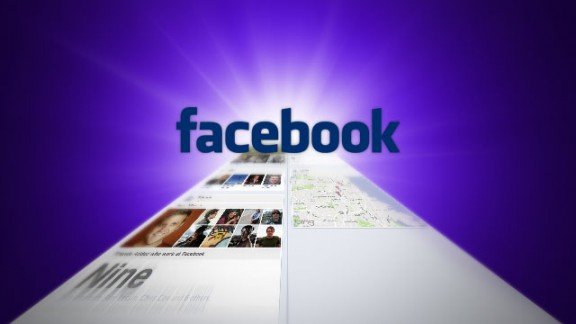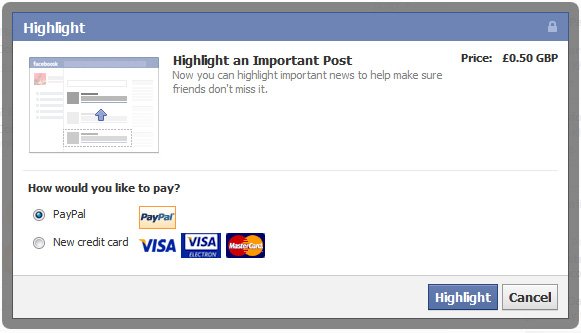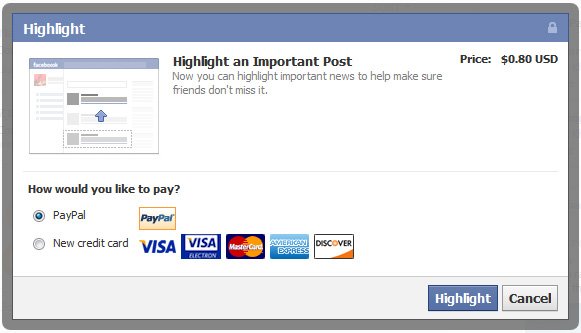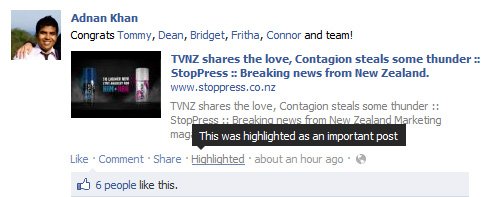Facebook puts a price on attention seeking

Facebook has a new highlighting feature to help people cut through the noise on the timeline. But will your friends thank you for it and will you be willing to pay for it?
Like Google, Facebook are often experimenting with minor tweaks and adjustments to their social network. These tweaks are often rolled out in a classic A/B test format (obviously with a few more letters of the alphabet) so that Facebook can get a feel for how people react to each level of adjustment.Very recently, (we noticed it on Friday 11 May), Facebook suddenly released the ability to highlight a Facebook post. In most cases, for a small price. The difference to their usual advertising options is that these highlighted posts are specifically for your personal profile.Facebook says:“Highlight an important post - Now you can highlight important news to help make sure friends don’t miss it.”For those that it’s been released to, the option appears as ‘Highlight’ text on a yellow background, just underneath a post that you’ve already made and alongside the ‘Share’ link. Note that it doesn’t display when viewing that same post on your actual profile page, only when viewing a post in your newsfeed.
How much does it cost?
When clicking the link, a pop-up box appears to request your payment details. This is where the A/B split testing comes in. When I clicked the link, I was presented with a payment option for £0.50 GBP.An example from Stuff.co.nz, as found by a Whangarei resident, shows the same box but with $2.00 USD required as payment (about $ 2.44 NZ). They checked with a Facebook spokeswoman, Mia Garlick, who confirmed that they were testing a few feature.I logged in under a different Facebook account and tried again, this time the payment required was £0.25 GBP. Checking with the Social Media NZ Facebook community, it didn’t take much to realise that others were seeing a range of different requests for payment. At least one contact even said that they weren’t asked for payment at all!This looks like it comes down – in part at least – to certain settings like the language you have chosen. On the two accounts that both displayed the price in UK currency, both were set to English UK language. When I changed one to English US, the price switched to $0.80 USD – a big drop from the $2.00 USD that the Whangarei resident had seen earlier in the trial. Funnily enough, that also affected the payment options. In the US version, American Express and Discover were available as payment methods. Quite odd as I wasn’t physically changing any of my address or location information under my “About” section, simply the language I was using to view Facebook.


Note: Before you go checking, switching the language to English (Pirate) doesn’t change the currency to gold bullion. I tried. I was disappointed.Stuff quotes Garlick as saying “This particular test is simply to gauge people’s interest in this method of sharing with their friends”. Looking at the various prices, you’d almost say that Facebook were experimenting to find a good price point.
What does highlighting a post actually do?
Despite some early comments from sceptics, highlighting a post isn’t quite as dramatic as it may sound. There’s no bold yellow highlight behind the post, just a subtle “Highlighted” underneath it, in a similar format to the “Sponsored” that you’ll often see in your sidebar, your newsfeed or on the mobile app. Even the prominence of the post wasn’t especially dramatic – when I viewed my newsfeed, I saw a good two or three stories in the “Sort by Top Stories” view before I saw a friend’s highlighted post, suggesting that highlighting doesn’t guarantee placement at the top of a feed.To speculate, I’d say that highlighting a post simply gives that post a good boost on the ladder between a bog standard post with no interactions and one with plenty of likes, comments, and shares. At this stage at least.
Even the prominence of the post wasn’t especially dramatic – when I viewed my newsfeed, I saw a good two or three stories in the “Sort by Top Stories” view before I saw a friend’s highlighted post, suggesting that highlighting doesn’t guarantee placement at the top of a feed.To speculate, I’d say that highlighting a post simply gives that post a good boost on the ladder between a bog standard post with no interactions and one with plenty of likes, comments, and shares. At this stage at least.
Is it ethical?
Allowing Facebook users to pay to get their personal posts placed higher in their friend’s own newsfeeds is a bold move by Facebook. Especially at a time when they’ve recently rolled out Timeline to Facebook Pages – a move that many Page admins would tell you has resulted in a decrease in natural views and interactions on their content and an increase in the need to spend money on Facebook advertising to get noticed.When you look at it in its most blunt format, highlighting a personal post says “What I have to say is more important than the updates of my friend’s friends and so should be more prominent”. You’re basically paying to gain more of your friend’s attention.Looked at in another light, it could be fair to say that with more and more people and brands joining Facebook, there’s a huge amount of noise to compete with. Sometimes you really may have something important to say and you’re happy to pay for that post to be seen over the posts of the many brands, old school friends, distant relatives, and dodgy co-workers that your friends may be connected to.
What’s next?
During this testing phase, Facebook will be carefully monitoring the reaction to this feature. If many do actually use it, they’ll also be carefully monitoring exactly how much those people are willing to pay and perhaps even the content of the posts that people are highlighting.If the reaction is less “OMFG” and more “Ooh what a handy feature”, Facebook will likely settle on a price point and roll the feature out to all users. Or perhaps it will only roll out to people that have checked the option to allow users to subscribe to their content? Or what about just to those who are admins of Facebook Pages? It’ll be an interesting one to watch, that’s for sure.What are your thoughts? If you could pay to get more eyes on a post from time to time, would you? What would you think of a friend who kept highlighting posts that you deemed to be of low importance? Would you think less of that friend? Have you had any experiences with highlighting a post that are different to the above? Let us know below.

